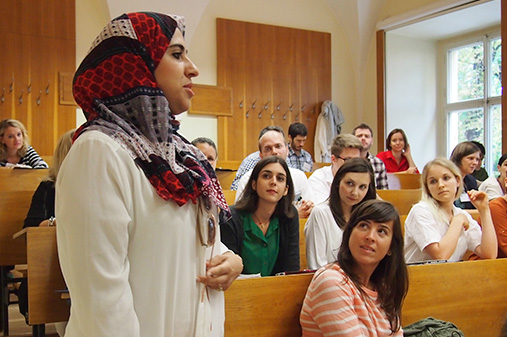What’s new for MSA? • 2025 MDS Congress
Dr. Morales: [00:00:00] Welcome to another episode of the MDS Podcast. I'm your host, Hugo Morales, and this is an update episode during the International Movement Disorder Society Congress in Hawaii. Today I have the pleasure of interviewing Dr. Alessandra Fanciulli from the Department of Neurology of the Medical University of Innsbruck.
View complete transcript
Welcome, Dr. Fanciulli.
Prof. Fanciulli: Thank you.
Dr. Morales: Now, in the recent years, there's been an increase in research output in multiple system atrophy with the effort to understand better the disease. But I wonder from your point of view, what are the unmet needs and what is the way forward?
Prof. Fanciulli: Thank you. Thank you for your question. The MDS really did a great effort in publishing new criteria for the diagnosis of MSA couple of years ago. And this definitely provided some [00:01:00] progress in diagnosing the disease. However, MSA is still oftentimes diagnosed very late in the disease course, and the rate of misdiagnosis is still high.
So we need tools to diagnose the disease earlier. Especially when people with MSA might be seen by field neurologists and not by movement disorder specialists yet. And these are mostly bedside tools, but when people come to the referral centers, then we need additional biomarkers to support the diagnosis.
And this field is very active. It's a very active field of research, both for diagnostic purposes and also to monitor the disease progression. Diagnostic wise, so the biomarkers we have of course, the synuclein seeding amplification assays. We have good signals for CSF, also in the prodromal phases of the disease. We have evidence that also blood-based samples might do the trick, [00:02:00] and we're eager to replicate this finding for a large-scale application.
Interesting developments are also from the skin biopsy field, where you can see the synuclein aggregation, and depending on the pattern and also the accompanying neuropathy, you have made distinctions between alpha-synucleinopathies. And of course, neuroimaging. Neuroimaging is a very interesting biomarkers to explore also what concerns disease progression and target engagement and when it comes to disease modification. Because of course, MSA is a very rapidly progressive disorder, a fatal one, and we definitely need a cure. But how to measure whether an investigational compound is doing it its job. We need readouts, biomarkers, and neuroimaging has a potential there.
And this is another unmet need: a cure for MSA. Luckily, we are very happy to see that there is an [00:03:00] increasing interest from the industry in engaging in slpha-synuclein. So in multiple system atrophy, disease-modifying programs.
And basically we have three targets in this disease modification. One is reducing the levels of toxic aggregated alpha-synuclein. This with different strategies, starting from transcription, or increased clearance, or interfering with oligomerization. Other approaches target neuroinflammation trying to reduce this neuroinflammation. And there were some preliminary results communicated earlier this year. And another approach is increasing the level of stimulating growth factors, which are lost when you have this oligodendroglial cell death. We really hope that these compounds would help us find a cure in the future.
In the meantime, it is mandatory for us as MSA physicians to care for these people. So [00:04:00] to provide the best possible care, which should be multidisciplinary. It's not only the neurologist, but it really takes a village to care for all MSA symptoms and most importantly, for people living with this disease. And in this case, the goal is warranting autonomy in daily life, preserving quality of life, whatever this means for people living with MSA and their loved ones, and preventing complications of the disease, which are sometimes life-threatening, like infections, falls, pneumonia, choking.
And so research lines are also moving there. So both new symptomatic approaches to treat orthostatic hypertension, but also developing new models of care to warrant continuity of care from the early stages where this is, let's say, easier towards the more advanced one, where also disability and geographical barrier play a role.
I really [00:05:00] believe that telemedicine and mobile palliative care will help in this case. So a lot of things ongoing. I really hope this will impact on the future MSA care.
Dr. Morales: So it seems that the field is moving to early diagnosis with using biomarkers and more sort exquisite imaging modalities. They're more specific. But from your point of view, as a MSA expert, do you think clinicians are now more equipped or better at diagnosing MSA as compared to, let's say, 10 years ago?
Prof. Fanciulli: I think the new criteria that were developed by the MDS Task Force really did an effort in increasing the sensitivity for MSA. And of course there was also a lot of work in communicating. So making these tools available to the colleagues. I don't like the word educating because we are not educating anybody, but sharing the good news that we now have better [00:06:00] diagnostic tools that we had maybe 10 years ago.
Dr. Morales: Thank you, Dr. Fancuilli for giving your insight and update on multiple system atrophy. And audience, stay tuned for our next episode where we'll continue exploring the latest advancement in movement disorders during the Congress. Thanks.
Prof. Fanciulli: Thank you.

Alessandra Fanciulli, MD, PhD
Medical University of Innsbruck
Innsbruck, Austria









